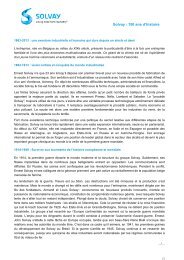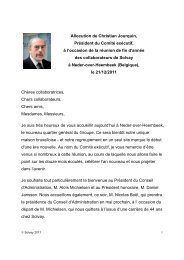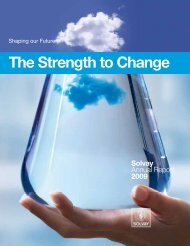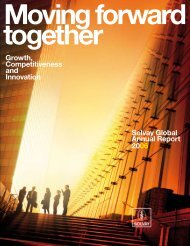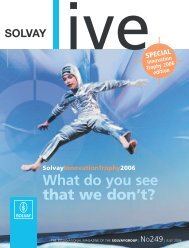THE FUTURE, - Solvay
THE FUTURE, - Solvay
THE FUTURE, - Solvay
You also want an ePaper? Increase the reach of your titles
YUMPU automatically turns print PDFs into web optimized ePapers that Google loves.
Sustainable<br />
development<br />
and citizenship<br />
52<br />
Sustainable development and citizenship > INNOVATIONS 09<br />
209829 209833<br />
SOLVAY GROUP SUSTAINABILITY TARGET NO<br />
18: INFLUENZA PANDEMIC PREPAREDNESS<br />
PROJECT<br />
Ready for tomorrow<br />
<strong>THE</strong> PROJECT. The negative effects of a<br />
pandemic on <strong>Solvay</strong> people and businesses could<br />
be considerable. A Pandemic Preparedness<br />
Project recognizing the necessity of robust<br />
contingency planning to mitigate the effects of a<br />
global pandemic on <strong>Solvay</strong> personnel and<br />
the businesses has been established. Essential<br />
businesses are prioritized to give best chances for<br />
continuity. Hygiene kits help reduce the risk of<br />
spreading and contracting infl uenza. Good quality<br />
information prepares people to protect themselves<br />
and their families. Stockpiled antiviral medication<br />
can reduce the severity and health consequences<br />
for those getting fl u. Country plans and local<br />
pandemic champions are added tangible<br />
manifestations of <strong>Solvay</strong>’s commitment to the<br />
health and wellbeing of its people.<br />
PHARMACEUTICALS SECTOR<br />
> Roger Bickerstaffe; Christiane Baleux;<br />
Carole Berthelot; Jean-Paul Bindelle;<br />
Ann Faseur; Hans-Jürgen Korte; Claes Martenson;<br />
Claude Michel; Belinda Schatteman;<br />
Sarah Shaw; Martial Tardy; Herman Van Heemstra;<br />
Herbert Vanderstrate.<br />
ZEBRAFISH IN PHARMACOLOGY RESEARCH:<br />
REDUCING USE OF RODENTS<br />
Fish that are more useful<br />
than rodents<br />
<strong>THE</strong> PROJECT. In the neuroscience early<br />
research area, one of <strong>Solvay</strong> Pharmaceuticals’<br />
two main areas of research, selecting interesting<br />
compounds for further study is diffi cult,<br />
time-consuming and requires the use of large<br />
numbers of rodents. Using zebrafi sh offers<br />
possibilities for a signifi cant reduction in the use<br />
of higher-order animals in early research and in<br />
the quantity of compound required for early tests.<br />
What’s more, the chances of success are<br />
expected to be greater when conducted with<br />
compounds that show effects in zebrafi sh. Using<br />
zebrafi sh is also a great deal easier and more cost<br />
effective than housing and handling rodents.<br />
Finally, reducing and refi ning our use of animals is<br />
integral to our animal-use policy.<br />
PHARMACEUTICALS SECTOR<br />
> Eric Ronken; Antoinette Degroot;<br />
Wouter Kamphuis; Nanning Takes;<br />
Susanne Thun-Battersby.<br />
209904<br />
TAVAUX PLANT BIOMASS PROJECT:<br />
ELECTRICITY AND STEAM PRODUCTION<br />
FROM RENEWABLE RESOURCES<br />
Tavaux turns to wood<br />
<strong>THE</strong> PROJECT. The Tavaux (France) biomass<br />
project has two specifi c objectives, both in line<br />
with our strategy of sustainable development:<br />
• diversifying our energy supply by disconnecting<br />
from the market for fossil fuels;<br />
• reducing CO 2 emissions by our industrial<br />
activities.<br />
Approximately 300 000 tons of biomass per year,<br />
mainly of forest origin, will cover 15% of the<br />
plant’s needs (20% after conversion of electrolysis<br />
to membrane technology).<br />
At the same time 70 000 tons of CO 2 less per<br />
year will be produced, corresponding to an overall<br />
reduction of these emissions by 20% compared to<br />
the current situation, where energy is produced<br />
from gas and coal.<br />
This project, selected and approved by the French<br />
government in 2008, is in response to a national<br />
call for projects to promote the use of biomass,<br />
launched in late 2006.<br />
It owes its success to many factors including:<br />
• team spirit among all participants in the project;<br />
• support from the Competence Centres<br />
concerned;<br />
• excellent communication, in particular with<br />
neighbouring communities and elected local<br />
politicians, whose support has been gained in<br />
this way;<br />
• a strong external partnership with Dalkia, a<br />
subsidiary of Veolia;<br />
• unconditional commitment from plant<br />
management and from the Management<br />
Committee in particular.<br />
SBU EDS<br />
> Michel Frasca; Christian Clerc-Girard;<br />
José Granercarbona; Alain Michel; François Morel.




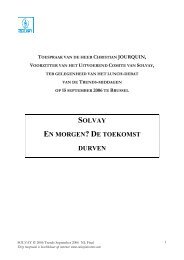
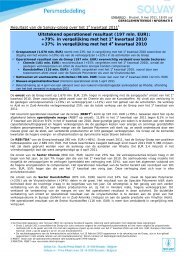

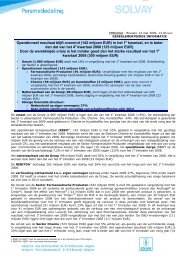
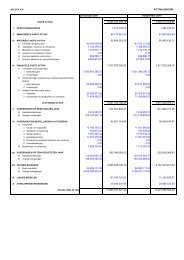

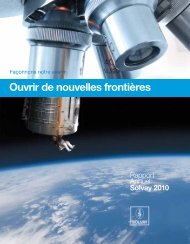
![PROC.1 [LETTRE] - Solvay](https://img.yumpu.com/16585746/1/184x260/proc1-lettre-solvay.jpg?quality=85)
